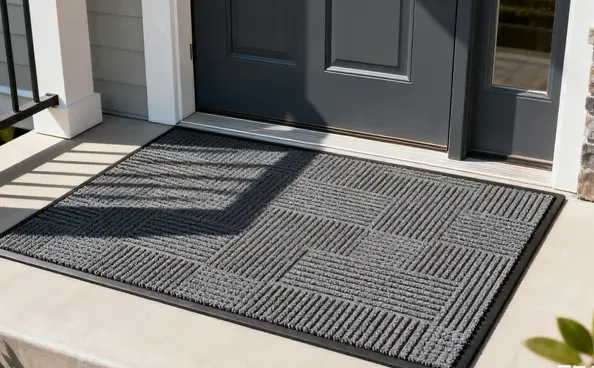Choosing the right outdoor door mat is essential for keeping your entryway clean and welcoming. A good mat does more than just look nice—it also protects your floors, traps dirt, and keeps moisture outside. But with so many options available, how do you know which one is right for your home?
The best outdoor door mat should be durable, weather-resistant, and effective at trapping dirt, debris, and moisture.
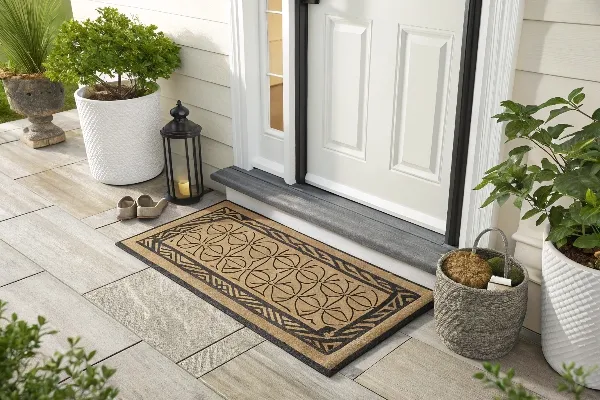
With so many choices out there, it’s easy to feel overwhelmed when picking the right mat. Whether you want something low-maintenance, eco-friendly, or simply stylish, the following sections will break down what you need to know to make the best choice.
How do I choose an exterior door mat?
Die Wahl des richtigen exterior door mat1 requires balancing both aesthetics and functionality. You want something that’s going to last, while also serving the purpose of keeping dirt, water, and debris outside.
Wann choosing an exterior door mat, you must consider the material, texture, and design to ensure it will stand up to the elements and efficiently trap dirt and moisture.
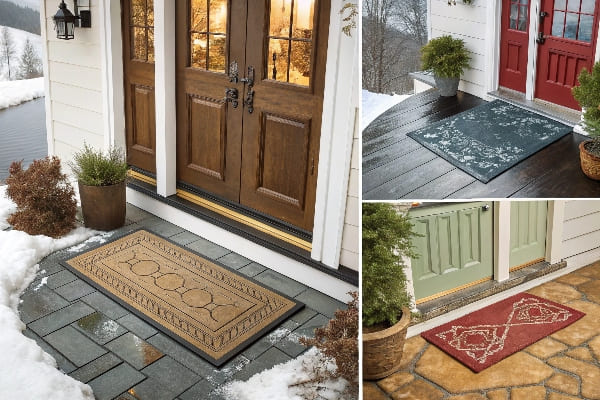
Material
Start by considering the material of the mat. There are several types to choose from, each with its own benefits and limitations:
-
Coir Mats: Coir mats, made from coconut husks, are excellent for scraping dirt off shoes. They have a natural texture and are often biodegradable. However, they can wear out quickly if exposed to a lot of moisture, so they may not be ideal for rainy climates.
-
Gummimatten: These mats are durable, weatherproof, and easy to clean. They can withstand all types of weather conditions, making them a good choice for any region. The only downside is that they can sometimes have a rubbery smell, but that dissipates after a few days.
-
Matten aus synthetischen Fasern: Synthetic mats (made of polyester or nylon) are water-resistant, easy to clean, and quick to dry. They are often made with a textured surface to trap dirt and water, but they don’t have the natural look of coir.
-
Mikrofasermatten: These are quick-drying and capable of holding a significant amount of moisture. They’re soft underfoot and often come in a wide range of colors and designs. The downside is they may not be as durable as rubber or coir mats when exposed to the outdoors over long periods.
Größe
Size matters. A mat that’s too small won’t do much to keep dirt from entering your home, while a mat that’s too big can overwhelm your entryway. Typically, a mat should cover enough space for a person to step on as they enter and exit the house.
-
Standard Size: A typical outdoor mat size is 18×30 inches. This works well for single doors. If you have a double door or a larger entryway, you may need something bigger, like 24×36 inches or larger.
-
Mat Thickness: The thickness of the mat is another factor to consider. A thicker mat can better absorb moisture and dirt, but it should still fit under your door when it swings open.
Design
Design plays a role in aesthetics but also in functionality. Some mats have patterns and textures that help trap dirt better, while others have raised borders to catch water. Choose a design that fits both your style and your practical needs.
How do you weatherproof a doormat?
Outdoor mats need to be weatherproofed to withstand rain, snow, and sun. Without proper protection, even the most durable mat will wear out quicker and fail to do its job of keeping dirt and moisture outside.
To weatherproof your doormat, consider choosing a mat made from weather-resistant materials or apply a protective coating to extend its lifespan.
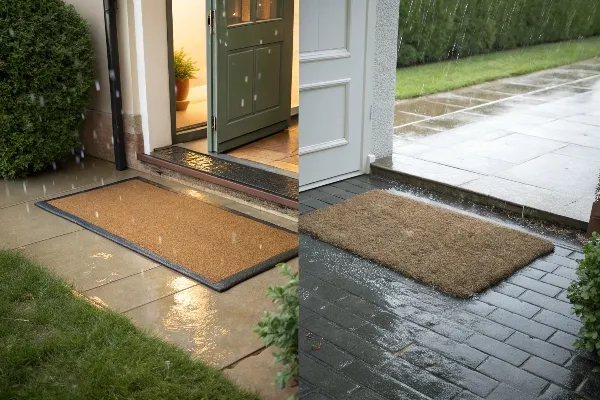
Here are some tips for keeping your doormat weatherproof:
Materialauswahl
-
Gummimatten: Rubber is naturally weather-resistant and works well in almost any condition. These mats are easy to clean, durable, and won’t fade under direct sunlight. Rubber also doesn’t absorb moisture, so it won’t mold or mildew.
-
Coir Mats: Although coir is highly effective at scraping dirt, it’s not the best material for wet climates. Coir fibers can become soggy and break down when exposed to moisture for long periods. If you like the look of coir, consider using it in a covered area where it’s not constantly exposed to rain.
-
Synthetic Mats: Many synthetic mats (such as those made from polypropylene) are designed specifically for outdoor use. They’re resistant to mold, mildew, and fading from sun exposure. These mats are low-maintenance and can withstand prolonged exposure to moisture.
Waterproofing Treatment
If you have a coir or cotton mat, you can apply a waterproofing spray2 to protect it from water damage. A water-resistant coating helps prevent mold and mildew from developing, which can make your mat last longer. Be sure to choose a non-toxic, eco-friendly spray to avoid harming the environment.
Cleaning and Maintenance
Regular cleaning is one of the best ways to protect your mat from wear. Shake it out or vacuum it to remove dirt and debris. For deeper cleaning, rinse the mat with a hose and allow it to air dry. If your mat is exposed to heavy rain, try to store it in a dry area to prolong its life.
Should you put a door mat outside?
Yes, putting a door mat outside your home is not only practical but can also add to the curb appeal of your house. A mat placed outside helps keep dirt, dust, and moisture from entering your home, making it easier to clean your floors.
Placing a door mat outside helps protect your floors, keeps your home cleaner, and adds a touch of style to your entryway.
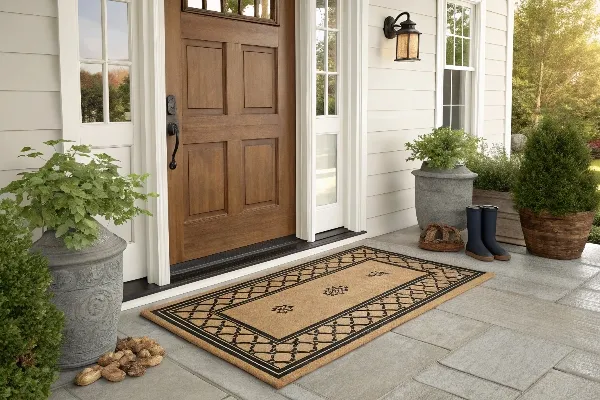
Here are a few more benefits of having an outdoor doormat:
Dirt and Debris Control
One of the main reasons people use outdoor mats is to prevent dirt from being tracked into the home. Every time you or a guest step outside, your shoes collect dirt, leaves, and other debris. A doormat provides a simple way to
How big should an outdoor door mat be?
The size of your outdoor mat should complement the size of your door and entryway. A mat that’s too small may not serve its purpose, while one that’s too large could clutter the space.
An outdoor doormat should be large enough to accommodate the space in front of the door while still allowing the door to open freely.
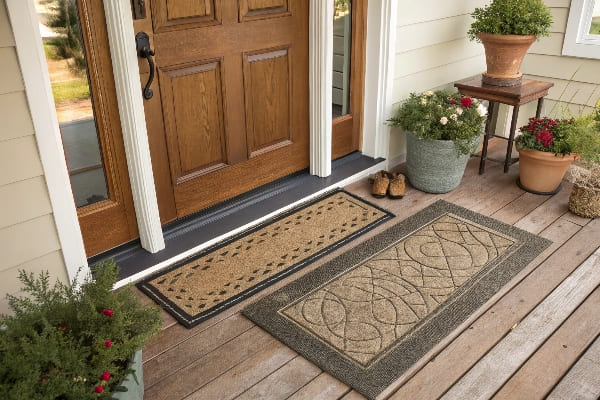
Here are some size guidelines3:
-
Single Door: For a single door, a mat that measures 18×30 inches is usually sufficient. It’s large enough to catch dirt while not taking up too much space.
-
Double Door: If you have double doors, go for a mat that’s 36 inches wide or larger. Larger mats will cover more surface area, helping you effectively trap dirt and water from both sides of the doorway.
-
Wide Entryways: If you have a wide entryway, you may want to opt for a mat that extends across the entire space. Choose a mat that’s 36×60 inches or even larger for maximum coverage.
Dicke
Another important factor is the thickness of the mat. A thicker mat will absorb more moisture and dirt, but it should still be thin enough to fit comfortably under your door without obstructing its movement.
What is the best color for a door mat?
The color of your outdoor doormat can enhance the look of your entryway and even hide dirt. Darker colors are often better at hiding dirt, while lighter shades can add brightness to your doorstep.
The best color for a doormat depends on your personal preference and the look you want for your entryway. Darker tones are more practical for hiding dirt, while lighter hues can create a fresh, welcoming atmosphere.
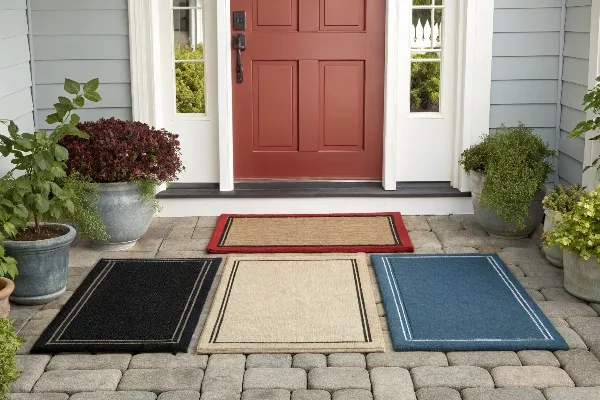
Here are some tips for choosing the best color:
Dunklere Farben
Colors like black, brown, or gray are ideal for hiding dirt and stains. These tones blend well with almost any exterior design and look good with most homes. Darker mats are especially good if you’re looking for something low-maintenance, as they won’t show dirt as quickly.
Lighter Colors
If you want to add a pop of color to your porch, go for bright hues like red, blue, or yellow. These colors can make your entryway feel more inviting and cheerful. Keep in mind that lighter colors show dirt more easily, so they may require more frequent cleaning.
Neutrale Töne4
Neutral colors like beige, taupe, or charcoal are versatile and timeless. These shades complement nearly any home exterior and give off a more understated, classic look.
Abschluss
Choosing the right outdoor doormat involves balancing durability, functionality, and style. Consider materials like rubber, coir, or synthetic fibers, and think about size, design, and color to ensure you select a mat that will last and enhance the look of your home.
-
Explore this resource to find expert tips and recommendations for selecting the perfect exterior door mat that suits your needs. ↩
-
Learn about the effectiveness of waterproofing sprays and how they can protect your doormat from water damage. ↩
-
Explore detailed size guidelines to ensure your outdoor mat fits perfectly and serves its purpose effectively. ↩
-
Learn about the timeless appeal of neutral doormat colors and how they can complement various home exteriors effectively. ↩

